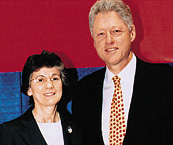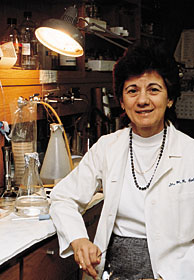
Colwell Research Breaks Cholera Myths
While at Maryland, she spent most of her quarter century there proving to the scientific world that Vibrio cholerae, the causative agent of cholera, behaved far differently than everyone believed.
The conventional wisdom was that cholera was spread from person to person, primarily from people arriving in port cities on ships. In the 1800s, doctors didn't really know what caused it or how to cure it. It was only in the mid-1800s that the world's first epidemiological study—conducted by British physician John Snow—discovered that many victims had been drinking from the same well. It proved the connection to contaminated water supplies.

Colwell joins President Clinton at the American Association for the Advancement of Science meeting in Philadelphia in February 1998, shortly after the president nominated her to be NSF director. Photo courtesy Rita Colwell.
The search for a cure was intense because the disease was terrifying. The first cholera outbreak was recorded in 1817 in Persia and Turkey, killing thousands and leaving untold others sick. V. cholerae, which hit the Western Hemisphere in the 1830s, disrupts the transport of sodium and potassium in cells lining the intestines, causing diarrhea so severe that a person can lose more than 50 percent of his or her body weight, and death can occur in a matter of hours.
Scientists were pretty certain that cholera was spread by feces, food and water. But a vital question remained: what happened to the bacteria in between epidemics, when cholera seemed to disappear for years? And how could the disease strike different parts of the globe at the same time?
Colwell came to believe that V. cholerae survived in the ocean. In the 1970s, she and her research team discovered the cholera bacterium in the waters of the Chesapeake Bay—a stunning fact, considering there were no outbreaks of the disease anywhere near the Chesapeake—or that the last cholera epidemic in the United States occurred in 1911. The idea that V. cholerae could exist in the waters off big U.S. cities was deemed preposterous.
The idea that the bug could exist in the environment without a human host, too, was considered just as absurd.
"We were excoriated," Colwell recalls. " 'Nonsense,' they told us. 'It's only transmitted from person to person.' I was mocked and ridiculed by people who set themselves up as Colwell criticizers. It was not very nice, but you keep going."
As it did years earlier, her stubbornness prevailed. More than 300 scientific research papers later, her ideas gained acceptance. "Unlike others who have studied pathogens," explains James T. Staley, a professor of microbiology at the UW School of Medicine, "she looked at the natural habitat in which V. cholerae resides to determine how it lives away from its host. Her lab discovered that the organism resides in marine and estuarine waters by virtue of its ability to attach to and to grow in association with zooplankton."

In addition to being NSF director, Colwell runs one of the world's leading research laboratories on cholera at the University of Maryland. Photo courtesy of the University of Maryland.
Her studies of the ecology and epidemiology of the bacterium in Chesapeake Bay were applied to India and Bangladesh, where cholera outbreaks are common. "Her studies have led to a recognition of the important environmental parameters associated with flooding that lead to outbreaks of the disease. Her research has combined ecology and epidemiology in a novel and important way that has led to a better understanding of how the disease can be controlled," Staley adds.
By the mid-1900s, after cholera epidemics had circled the globe six times, water supplies and sanitation systems had been so improved that it appeared the disease was having less and less of an impact. Many began to think it would only plague developing nations.
Then in 1961, cholera returned with another pandemic. In 1991, it struck South America, where it had not been seen for more than 100 years. Colwell suspected that the bug persisted in an environmental reservoir—the ocean—as if waiting for the hosts to come along. She had found the bacteria in Chesapeake Bay (though no one believed her) and she wondered if it was just a matter that the bacteria couldn't be seen—or that people hadn't looked hard enough for it. Perhaps it was the traditional culture methods that weren't working. "I wondered if it goes into a dormant state," she says.
In the 1970s, a small cholera outbreak hit near New Orleans among people who had eaten crab from a local bayou. She went back to collect water samples, but this time, instead of doing a culture, she tried something new—using an antibody that would grab onto a key component of the bacterium's cell membrane. A molecule in the antibody would light up under ultraviolet light. Sure enough, she was right. "We did a little tribal dance around the microscope," she says. It showed the bacterium did go into a dormant state.
Besides her continuing work on cholera at her lab at the University of Maryland, Colwell is putting her considerable energy into being a teacher and mentor on the biggest stage: forging interdisciplinary research, promoting information technology, pushing an emphasis on learning science. It's something she and Jack (a physicist) used at home in raising her two daughters, Alison (a fish disease specialist at the U.S. Geological Survey in Sand Point) and Stacie, now finishing an M.D./Ph.D. program. "I told my daughters they could major in whatever they wished, but they had to take math and calculus and two years of chemistry," she says. "I wanted to expose them to science and see what opportunities were out there."
Among the initiatives she is pushing is major system reform to improve science and mathematics learning in K-12, better teacher preparation, coordinated K-12 and college-level academic requirements to create a seamless education system and improved instructional materials.
She is also advocating more federal support for information technology and its links to the pursuit of basic scientific research. "This will be one of the most important ventures NSF can launch in the coming years," she says. For instance, she cites the success of astronomers in developing computer-based methods to analyze data, such as surveys of the billions of stars in the sky.
Her fundamental belief is that boundaries between disciplines be dissolved, citing her own work on cholera. Her studies, for example, integrate data from oceanography, epidemiology, ecology, microbiology and clinical medicine.
"Only by bringing together multitudes of disciplines do you see the major advances that mean so much to society," she explains. "We know magnetic resonance imaging emerged from chemistry and physics but we forget that they never would have become what they are without advanced mathematics. Doppler radar pushed the limits of atmospheric science, information science, and engineering—and opened up new frontiers in each."
So the girl who was once told that science was not a profession for her gender carries on her crusade, excited at the future. Of those who snubbed her in the past, she only smiles. "Success," she says, "is the best revenge."
Go To: Page 1 | Page 2 | Page 3 | Page 4
- Return to June 2000 Table of Contents